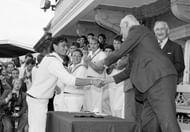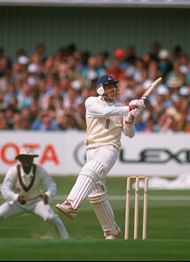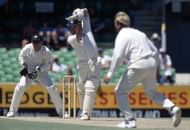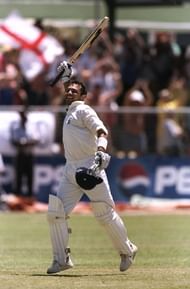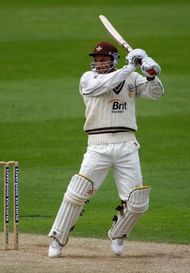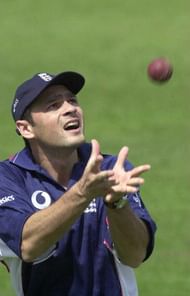On June 6th, 1991, the West Indies’s bloodthirsty fearsome foursome pace-attack consisting of Courtney Walsh, Curtly Ambrose, Patrick Patterson, and Malcolm Marshall were smelling blood against England at Headingley.
While facing up to the ruthless-machinery of mass-destruction from the Caribbean Islands, England’s batsmen seemed to be quivering for cover. But a smart and handsome looking 21-year old young man in Mark Ramprakash, with a dash of bravado played for close to two and half hours and showcased the kind of technical brilliance that would make a 50-Test match veteran proud.
Mark Ramprakash, born on September 5th, 1969 in Bushey, Hertfordshire was an enigma of English cricket. While facing up to bowlers of the highest calibre like Curtly Ambrose, Courtney Walsh, Allan Donald, Waqar Younis, Wasim Akram, Anil Kumble and company in county cricket, his poise, balance and fluidity at the crease invoked respect and reverence from one-and-all.
But at the same time, he just couldn’t fulfill his true potential at the top echelons of international cricket. His Test batting average of 27.32 didn’t do justice to his burgeoning potential.
Early Days
Mark Ramprakash is of Indo-Caribbean and English descent, as his father was Indo-Guyanese and his mother English. He attended Gayton High School, followed by Harrow Weald Sixth Form College.
His first cricket club was Bessborough Cricket Club in Headstone Lane. When he played for various age groups, he didn’t just leave an indelible mark as a batsman, but was a promising pacer too. In fact, opposition teams were said to be scared of bowling to Ramprakash. As he was a bit of a stormy character during his early days, the only way it seemed like the opposition camp could trouble him was if someone sledged him or winded him up on a cricket field.
Martin Bicknell, who played for Surrey and England, reflected on Mark Ramprakash’s early cricketing career, “I think the first time I came across Ramps must have been in an under-15 game between Middlesex and Surrey – don’t ask me the year. He was playing a year up, because he’s a few months younger than me, and we knew all about him – he was probably the most talked-about boy in the country. So he came into the game with a great reputation, and he didn’t disappoint – he got runs, and he also ran in and bowled quickly, because he was a bowler too in those early days. He was always going to be a bit of a star.”
Mark Ramprakash shows flashes of brilliance in county cricket
Mark Ramprakash came through the ranks by accruing a truckload of runs and was soon playing for Middlesex seconds at the tender age of 16.
He didn’t exactly set the World on fire while playing for Middlesex seconds. However, the Middlesex’s management perhaps knew that he was one of the brightest lights in the county circuit, and as a result, they drafted him into the Middlesex county squad for the 1987 first class season.
In his first county match for Middlesex against Yorkshire at Headingley, Mark Ramprakash grabbed the golden opportunity with both hands.
He passed the litmus test of facing up to a formidable bowling line-up consisting of Arnold Sidebottom, swing-merchant Paul Jarvis and the diligent workhorse Phil Carrick, with flying colours. Incidentally, Ramprakash’s courageous knock of 63 in his first county match against Yorkshire turned out to be the top score in Middlesex’s second innings.
Mark Ramprakash though, had to wait for more than two years to score his maiden first class century against the White Rose county – Yorkshire. But by then, he had already shot into prominence for his nerve-wracking knock of 56 in the NatWest trophy final against Worcestershire at Lord’s in 1988.
On a track with plenty of juice in it for the seamers to exploit, Ramprakash showed incontrovertible self-belief and controlled mastery to wash away the challenge posed by Worcestershire’s seamers with aplomb. For his gritty knock, Ramprakash, won fulsome praise and filled columns in the papers — flowing with thunderous applause.
It was during the 1990 English first-class season when Ramprakash made gallons of runs and it seemed like just a matter of time before he would make his Test debut for England. It was a season in which he amassed 1541 runs at an impressive average of 48.15.
Among the five centuries he essayed during that English county season, the epoch-making moment of his fledgling career was when he made 119 in a low scoring game against Derbyshire at Derby County ground.
In spite of having a modest bowling line-up, Derbyshire made early inroads into Middlesex’s experienced batting line-up. It was only Ramprakash who launched a rescue mission with a career-defining knock of 119 in the first innings. Unfortunately for Ramprakash, Simon Base and the diligent workhorse from Denmark, Ole Henrik Mortensen, snared 13 wickets between them, as Middlesex crashed to a heavy defeat. Ramprakash must have felt like being a boy on a burning deck in the first innings.
Mark Ramprakash’s struggles in Test cricket
With the weight of runs behind him, Ramprakash finally made his Test debut against the pillaging West Indians at Headingley in 1991. Interestingly, Graeme Hick too made his debut in that Test.
For Ramprakash, it was a strange series, in the sense that with hard-work and dogged determination, he invariably got starts, but was never able to capitalise on those promising starts. The consolation for Ramprakash came in the form of him being voted as the Cricketer Writers’ Club Young Cricketer of the Year.
Mark Ramprakash soon became the victim of England’s haphazard selection policies that existed during the dark days of English cricket in the 1990s. It took only a few failures against Sri Lanka and Pakistan respectively in 1992 for England’s selectors to decide that he should be dropped from the team.
Mark Ramprakash made a comeback into the England team in the fourth Test of the series against Pakistan at Leeds in 1992, only to be dropped again after the final Test at Oval. In many ways, Ramprakash’s stop-start Test career encapsulated the very essence of English cricket’s deep-rooted problems in the 1990s.
England’s selectors ‘revolving-door policy’ didn’t deter Ramprakash one bit. By doing reasonably well in the county circuit, he worked his way back into the national set-up for the Oval Test against Australia in 1993.
The 1993 Ashes series was a disaster for English cricket, as going into the final Test at the Oval, Australia had already clinched the series 4-0. Most of the English batsmen were at sixes and sevens, while facing up to Shane Warne‘s magical box of tricks.
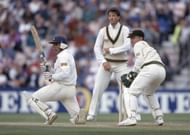
Mark Ramprakash in the final Test of the 1993 Ashes series, which England won by 161 runs, coming into the match 0-4 down in the series
In the second innings of the final Test at the Oval though, Ramprakash, brought a whiff of fresh air into their batting line-up with a masterful knock of 64. ‘Ramps’, as he is popularly known, came into bat at only the number seven slot in the batting-order.
But by showcasing a twinkling footwork against Warne, twinned with presenting a straight bat when needed against seamers, his timely half-century went a long way in helping England to eventually win the dead rubber by 161 runs.
For their next trip to the Caribbean in 1993-1994, England’s selectors plumped for youthful exuberance over experience. However, for the umpteenth time, West Indies proved to be too strong for the young guns from British Isles. Ramprakash himself had a horrid series, as he aggregated a paltry 73 runs in four Tests at a highly disappointing average of 10.43.
For almost two decades, West Indies’s deadly fast bowling machinery wreaked the fledgling careers of batsmen all over the cricketing world. By the end of England’s trip to Caribbean, it was crystal clear that Ramprakash too had developed a mental block of facing up to Ambrose and Walsh.
To make it even worse for Ramprakash, he was slotted into bat at the crucial number three position for the entire series. Here was a batsman who was still finding his feet in international cricket, but the English management thought that he could bat at the number three slot and make mountains of runs against Ambrose, Walsh and company.
On expected lines, after the series against West Indies, Ramprakash found himself in the lonely world of wilderness. In the peace and tranquillity of quintessentially, well-manicured, scenic English grounds, Ramprakash found back his form. He virtually put all the county attacks to sword and made 1270 runs at a staggering average of 52.91 in 1994.
In spite of being ultra-consistent in the 1994 first class season, he was selected only to play for England A against India A in India. In the first unofficial Test against India A at Bangalore, Ramprakash, with a touch of equanimity and calm countenance was at his brilliant best against Indian spinners.
With a crisp downward angling of the willow, Ramprakash defended the Indian spin troika of Rajesh Chauhan, Utpal Chatterjee and Sairaj Bahutule stoically. Every time the Indian spinners bowled short or too full, he used the depth of the crease to carve out some sumptuous shots. The tinkle-toed elegance with which he used his feet to Indian spinners was a sight to behold.
Actually, when Ramprakash essayed the masterful knock of 99 in the first innings at Bangalore, the writer rubbed his eyes in sheer disbelief several times that a player of his calibre couldn’t find a place in the England’s squad during their ill-fated tour to India in 1992-1993.
Suddenly from nowhere, Ramprakash was selected to play for England to bolster an injury-hit English set-up in Australia. Critics weren’t sure about Ramprakash’s inclusion, as from playing on the slow and low wickets of India; he had to acclimatise to playing on a trampoline wicket at WACA. Ramprakash gave a fitting riposte to his critics by doing well at WACA.
Australia won the Test at WACA by a whopping margin of 329 runs, but not before the southpaw Graham Thorpe and Ramprakash put on a glorious exhibition of batsmanship. Thorpe came into bat at 5/2 in the first innings of the Test. But after surviving a searching examination of his technique by Glenn McGrath, he met fire with fire. When Thorpe pulled and cut Jo Angel and McGrath, the ball virtually crashed into the boundary boards at the speed of lightning.
At the other end of the spectrum, Ramprakash showed his versatility by making a well-measured knock of 72. In the second innings, he saved England from embarrassment with a tenacious innings of 42. Ramprakash’s judgment of what to play and what to leave against Australian seamers was close to ideal in that Test match.
After Ramprakash played those back-to-the-wall knocks at WACA, there was an inkling that the WACA Test could be the watershed moment in his career, but it wasn’t to be. Ramprakash’s cricketing career was back to square one after English selectors dropped him for the third Test against West Indies at Edgbaston in 1995.
The ‘revolving-door policy’ of England’s selectors continued to be the bane of English cricket with Mark Ramprakash being selected to tour the Rainbow nation in 1995-1996.
In South Africa, England’s think-tank made the same mistake that they had done previously in the Caribbean by slotting Ramprakash at number three position in the batting order. No wonder, Ramprakash flopped miserably during that tour and was eventually dropped from the team.
False dawn of Mark Ramprakash’s Test career
By 1997, Ramprakash seemed to be a forgotten man of English cricket. Just in the nick of time though, he was handed a lifeline by selectors, as he was picked to play against Australia in the final Test at Oval.
By then, it had become customary for Ramprakash to play in an Ashes dead rubber. On what turned out to be a spinner’s paradise, Ramprakash showed that runs could be eked out on a treacherous track by scoring 48 runs in the second innings.
By the time England toured the Caribbean in 1997-98, question marks were being raised over whether Ramprakash would even score a single hundred in his Test career. When ‘Ramps’ got the chance to play in the fifth Test at Barbados, he was able to take the monkey off his back of not having scored a century with a soul-lifting masterpiece knock.
At Barbados, for once in his Test career, Ramprakash reigned supreme. His marathon ultra patient vigil at the crease that lasted almost nine hours would be fondly remembered by aficionados for his great prowess of adhesion. For a youngster, watching Ramprakash bat was akin to a coaching stint in the art of leaving the ball outside the off-stump.
With Ramprakash getting a good run in the side, he started to make his presence felt at the Test level. In the 19 Tests he played from 1997 to 1999, starting with the Oval Test match against Australia in 1997, to the Oval test against New Zealand in 1999, Ramprakash averaged 40.27 and aggregated 1168 runs.
Unfortunately for Ramprakash, it turned out to be a false dawn in his Test career. In 1999, in the Test series played against New Zealand at home, he failed to deliver the goods and was soon dropped.
It has to be said that Ramprakash looked completely out of sorts in the Test series he played against the plucky Kiwis. It started with him making a duck for which he took 27 balls in the first Test at Edgbaston.
The nadir of that series for Ramprakash was when he made a painstaking 24 in the second Test at Lord’s and couldn’t even find gaps while playing against the friendly slow medium-pace of Nathan Astle. He seemed to be a cricketer full of jittery nerves and thoughts.
Final days of Mark Ramprakash’s Test career
Mark Ramprakash’s longtime friend and the then captain, Nasser Hussain, as well as England’s coach, Duncan Fletcher, were keen on recalling him back into the set-up. In the summer of England’s cricket season in 2000, he was given a chance to play against Zimbabwe and West Indies.
However, Ramprakash couldn’t stamp his authority in the few Tests he played that season. When he got out to the same old combination of Ambrose and Walsh in the famous Lord’s Test, it seemed for a moment that he had just played his last Test match. After losing his wicket to Walsh in the second innings of that Test, Ramprakash cut a forlorn figure while sitting and watching the game from the Lord’s balcony. Interestingly, 16 of his 52 Tests came against West Indies, in which he made just 591 runs at a disappointing average of 21.10.
In the 2001 Ashes series, England’s cricket team was reeling with injuries and loss of form to key players. It resulted in Ramprakash getting what was his final chance to make a name for himself in the Test arena.
In the early part of the series, he struggled to come to grips with facing up to a high-class Australian bowling line-up. The low point of the series for him being the horrible agricultural-hoick he tried to play against the Wizard of Oz, Warne, and gifting his wicket away on a platter at Trent Bridge.
Mark Ramprakash though, endeared to the capacity crowd at Oval in the final Test of the series with a sparkling century. It turned out to be his second and the last century that he would make in Test cricket. Australia’s champion cricketers were bewildered, as they just couldn’t believe their eyes that he was the same cricketer who played a horrendous shot at Trent Bridge.
During England’s trip to New Zealand the following year, Ramprakash played his final Test match. One vividly remembers Ramprakash’s last Test at Auckland, but for all the wrong reasons.
In what was a rain-marred Test match, and Ramprakash came in to bat with England tottering at 60 for 4. Instead of looking to rebuild the innings with a calm head on his shoulders, he tried to smash the cover off the ball, only for the bottom-hand to come off his bat handle and was caught behind by Adam Parore off Daryl Tuffey’s bowling.
As a keen cricket observer, I felt numb for a few moments, as one couldn’t envisage a player known for sheer technical brilliance trying a wild slog. It almost seemed like he wanted to take the frustrations of all the trials and tribulations of his entire Test career on the red cherry.
Mark Ramprakash touches exalted heights in county cricket
In spite of his Test career all but over, the willowy-master entered a phase of supreme unmatched excellence in county cricket. In 2001, he left Middlesex for Surrey, as he was disillusioned with Middlesex’s management. He also wanted to play in the first division of the County Championship.
In particular, 2006 was an annus mirabilis for Ramprakash. In that season, with a Stakhanovite–like vigour, he topped the batting charts by aggregating 2278 runs at a Bradman-esque average of 103.54.
Ramprakash’s achievement of becoming the first man to score over 150 runs in an innings in five consecutive matches was truly an awe-inspiring feat. He also became the first cricketer to aggregate over 2,000 runs in county cricket since Mike Hussey in 2001. He was duly recognised for his outstanding achievements in 2006 with him being voted as the Professional Cricketers’ association player of the year.
Riding on the wings of his excellence in 2006, the following year, Ramprakash was yet again very prolific in county cricket. He finished the 2007 season with 2,026 first class runs, including ten centuries, at an average of 101.30.
Ramprakash was also a thorn in the flesh of Lancashire’s team that season. His twin centuries in Lancashire’s final match at Oval in 2007 resulted in Lancashire losing a nerve-wracking contest and with it, the chances of lifting the coveted County Championship slipped out of their hands. It was a period in which Ramprakash was virtually scoring centuries and double centuries in torrents.
The insatiable hunger Ramprakash showed for his runs in county cricket made a few journalists believe that he should be recalled to play for England. But by then, England’s selectors were looking more towards youth rather than going back to Ramprakash.
In fact, Ramprakash was said to be very close to being selected for the tour to Emerald Isles in 2007-2008. When Ramprakash averaged 90 in the 2009 county season, a few eternal optimists again harboured hopes of Ramprakash playing in the Ashes series, but it wasn’t to be.
In 2008, Ramprakash touched heavenly heights in first class cricket by becoming only the 25th player in history to make 100 hundreds in first class cricket. It was a testimony to his amazing fitness that he could last more than two decades of gruelling professional cricket.
Ramprakash was no doubt a sui generis in terms of fitness. But all good things have to come to an end, as Ramprakash was sidelined with a career-threatening knee injury while playing a football match for charity in 2010.
By 2012, it was clearly evident that he was on his last legs as a player. So after dominating the county circuit like a run-making machine for more than two decades, he finally hung up his spiked boots last year. Since his retirement, Ramprakash has taken up the mantle of being the batting coach of his old county – Middlesex.
Mark Ramprakash’s athletic fielding
Mark Ramprakash was also a brilliant fielder. He seemed to be at ease with any fielding position that was allocated to him by the captain on a cricket field. Some of the jaw-dropping catches he took in his career will be etched in one’s memory forever.
A few instances of Ramprakash’s tigerish-like fielding are still fresh in fans’ memories – in his debut Test, with Ramprakash fielding at point, he made a full length dive to pluck a catch out of thin air to send Phil Simmons packing back to the pavilion.
In 1998, Ramprakash pulled off a stunning catch that helped England to dismiss the rock-solid Jacques Kallis at Headingley. Kallis played a scorching pull shot, only for Ramprakash to take a one-handed catch at mid-wicket.
In 1998-1999 at MCG, Australia was cruising to a victory. But Ramprakash turned the match on its head when with a superman-like leap; he caught Langer’s attempted pull shot of Alan Mullaly’s bowling at square-leg.
Life outside cricket
Other than cricket, Ramprakash has excelled in the glamour and glitzy world too. He and his partner, Karen Hardy, won BBC’s popular Strictly Come Dancing competition in 2006. He was also a talented footballer in his younger days, but gave up on football, as he wanted to seriously concentrate on taking up cricket professionally.
In recent times, he has had his fair share of problems in his personal life. Finally, Ramprakash and his lovely wife, Vandana Ramprakash, ended their marriage of 17 years with a divorce in 2010.
Here was a cricketer who was bestowed with a generous portion of god-gifted talent. Unfortunately, due to a variety of reasons, he couldn’t carve a niche for himself in the international arena. But that shouldn’t take anything away from his wondrous achievements in first class cricket.
Mark Ramprakash’s batting was more than just the 35,659 runs he amassed and 114 centuries he made in first class cricket. In short, just like a masterful painter, from his watertight defence to exquisite, precise metre of timing, everything seemed to be perfectly aligned.
Alas! The supreme willowy-wielder’s prestidigitation was largely restricted to the confines of first class cricket.
Follow IPL Auction 2025 Live Updates, News & Biddings at Sportskeeda. Get the fastest updates on Mega-Auction and cricket news

